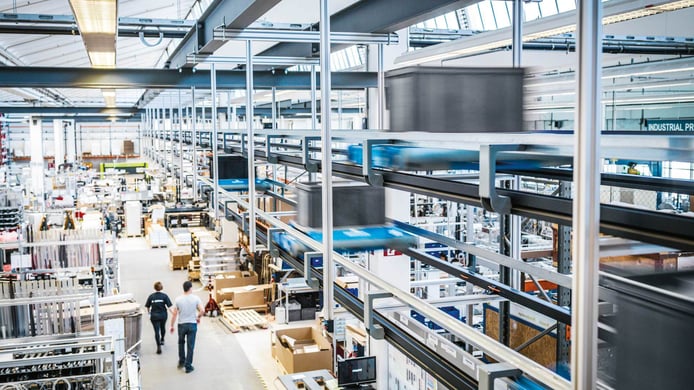Current Challenges in Intralogistics
Boosting efficiency in the value chain was the biggest talking point of the last year. Production processes were optimized to the max. However, intralogistics were neglected and the production and logistics realms were handled separately.
At the same time, the world continues to accelerate. More things are now bought from online stores than over-the-counter. Consumers no longer want off-the-shelf products, but one-offs, their very own totally unique products. In addition to this, there is the need to buy everywhere and at any time. This change in consumer behavior is overcoming the traditionally perceived limits of product availability.

Efficient intralogistics: Ideally, products and logistics merge to form a single unit.
Lead Times Become Drastically Shorter
Ideally, what is ordered today should reach the end customer today. Industries in which a delivery time of 48 hours used to be sufficient, now offer same-day delivery. Car buyers are no longer prepared to wait six months for their new vehicles; instead the new car rolls off of the production line shortly after ordering – and it is tailor-made.
The result is an explosion in variant diversity, with batch sizes becoming smaller and smaller right down to batch size 1.
These are the challenges of today and the future. And these challenges apply for all industries, no matter whether the automobile or supply industry, other production industries (mechanical and system engineering, electronics, food, medicine and healthcare, etc.) or in retail.
Process Assurance is a Prerequisite
For intralogistics, this means providing tremendous performance with one hundred percent availability, and this requires great speed and a high degree of process assurance.
Taking this into account, it is all the more important to develop smart logistics. The challenge here is to not construct an inflated logistics system, but to develop lean, dynamic logistics – if possible a continuous system without interfaces, which ensures that there are no isolated solutions, and thus opens up the doors for a one-piece flow.
In addition, product and production data is available in real-time through seamless intralogistics along the entire value chain; search times are avoided, feedback loops become shorter, thus improving process quality.
Where production and logistics merge into a single unit, the foundation for lean logistics is laid.
Read more about trends in intralogistics in our whitepaper: Lean logistics - Making intralogistics ready for the future

About the author
Christian Beer ist Inhaber und Geschäftsführer der Heron Gruppe mit den Firmen Heron CNC-Technik, Robotunits, Servus Intralogistics und SAFEDI

